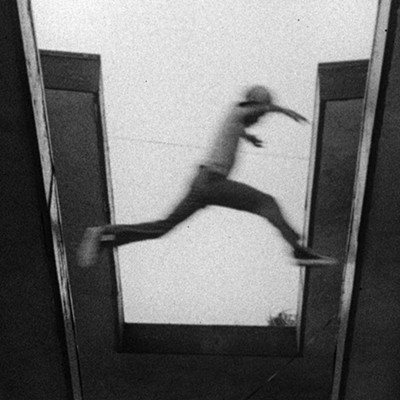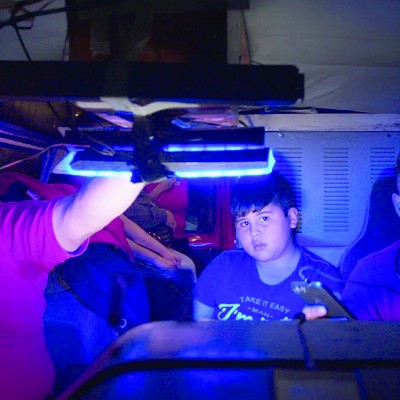The film The Fast Runner (Atanarjuat), which finally opens this weekend at The Loft in Tucson, has not only won the Caméra d'Or at the 2001 Cannes Film Festival but it was awarded six Genie Awards (the Canadian equivalent of the Oscar), including Best Picture and Best Director.
Set among small nomadic communities of Inuit hunters in the Canadian Arctic, The Fast Runner is a traditional tale of cultural strife, the violation of taboos, revenge, lust, love and forgiveness. The film is notable not only for its length (almost three hours) and its unconventional format (shot on digital video) but for its unique journey to the screen.
The folk tale of main character Atanarjuat has been a staple of oral storytelling traditions in Inuit culture for thousands of years, said first-time feature director Zacharias Kunuk. He first heard it as a child from his mother in the early 1960s while he and his five brothers were falling asleep in the family's sod house in Arctic Canada.
Kunuk and New York-born cinematographer Norman Cohn were in Tucson in May for a day of interviews as part of a tour promoting their film.
In the movie--which is set anytime from 500 to 2,000 years ago, the filmmakers said--the plot is set in motion when an evil shaman curses his community, the results being that Atanarjuat takes a liking to a young woman who has been promised to his rival. The young couple marries for love (defying tribal tradition) and all manner of chaos threatens to destroy the people.
Nicknamed "the fast runner," Atarnarjuat must live up to his reputation when he is forced to flee would-be killers, naked for miles across the ice, a thrilling and terrifying sequence that serves as the centerpiece of the production.
As a child in 1966, director Kunuk was sent to attend government-imposed school in the settlement of Igloolik, where he learned English and became enamored of American film stars such as John Wayne. He saw all sorts of movies projected by an old 16 mm on a screen in the town's community hall. "We even saw Frankenstein. That scared the shit out of me."
At the same time, he began carving Inuit figurines for money. Later in his teens, he learned that anyone could own a video camera. After flying to Montreal, Kunuk and buddy Natar Ungalaaq (who would eventually play the lead role in The Fast Runner), traded carvings for a video camera, a portable battery pack, a VCR and a 26-inch TV.
He returned to Igloolik, which didn't even have television until 1983, and started filming hunting trips. By 1990, he and his partners had started an independent film production company. They made mostly short dramas and a TV series set in the 1940s.
Like many folk tales, this one has many different versions. Each person tells the story slightly differently," said Cohn. "It's part of the magic of the oral tradition and what makes storytelling interactive and keeps it alive throughout the centuries."
More than six years ago, screenwriter Paul Apak Angilirq (who passed away from cancer in 1998) began making tape recordings of various versions of Atanarjuat's story while recording the oral histories of Inuit tribal elders, Kunuk said. The script grew out of those recordings.
For the 1998 shoot, which cost about $2 million Canadian (around $1.3 million American), Kunuk and Cohn assembled an all-Inuit cast of mostly first-time performers and a few seasoned acting professionals. The technical crew was 90 percent Inuit.
Because Inuit culture is not hierarchical, the production's shoot was more egalitarian, with several people acting as coordinators on the set. Obviously, Kunuk balks at the auteur theory of moviemaking, in which one artist (usually a writer-director) is the "author" of the film.
Even while cutting his teeth on shorter works for his production company, Kunuk said, "It never even crossed my mind to be the director, to direct the making of a movie. You just make it. It's your job."
The film was not only shot on location, but in locations identified as the actual spots where the story's events were supposed to happen, said Cohn. "The seaweed where Atanarjuat hides in the movie is actually supposed to be the seaweed, according to legend, where he did in reality."
Cohn's motto reflects that of most serious digital-video filmmakers: Use the best and most expensive equipment available at the time. In 1998, when The Fast Runner was shot, that was the $150,000 Sony DVW-700-WS, the first digital Betacam with wide-screen capabilities, which would come in handy when transferring the movie to 35mm film.
Said Cohn of his sophisticated tool, which weathered temperatures as low as 30 degrees below 0 (Fahrenheit): "If we had made this movie two years earlier, the technology simply would not have been good enough." Normally used for news-gathering, the camera's low-light capabilities made it possible for the crew to shoot in such extreme conditions as the interiors of igloos lighted only by traditional Inuit oil lamps.
Although The Fast Runner is an entertaining artistic statement, its main mission was as cultural education. It shows other cultures, such as those to the west and south, an accurate representation of Inuit life, including scenes of food preparation, sleeping accommodations, hunting and social situations.
Cohn said, "This film goes out to millions of people around the world who haven't seen the Inuit people represented totally accurately. It's meant to dispel misconceptions and to cause you to think in a way about certain people that maybe you have never thought of before."










